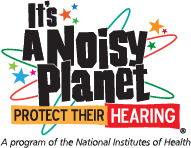Do you want earplugs with that burger?
Have you ever had to raise your voice to the level of a shout to be heard when dining out? Yes? You aren’t alone!

The next time you eat out, look and listen. Is the restaurant a big room with a high ceiling? Are there lots of hard surfaces like metal and concrete? Are tables crowded together? Hard surfaces and open spaces make sounds bounce and echo, so the sounds seem even louder. And when you raise your voice, other people have to talk louder to be heard, too.
Noise levels in restaurants are a growing concern for patrons, employees, and restaurant owners alike. In fact, nationally known reviewers have started to include the loudness of restaurants as factors in their ratings. And with good reason. A recent Zagat Dining Trends Survey found that noise in restaurants was ranked as diners’ top complaint.
Research shows that long or repeated exposure to sounds at or above 85 A-weighted decibels (dBA) can cause noise-induced hearing loss. Signs of having been exposed to too much noise include not hearing clearly or having ringing in your ears after leaving a noisy environment. According to Restaurant Briefing, reviewers have noted noise level averages of 80 dBA or higher in restaurants around the country. (A typical conversation averages about 60 dBA). These noise levels can make conversations more difficult and put diners’ hearing at risk. In addition, having to speak over the dining room din could also put an unhealthy strain on customers’ voices.
Noise levels can pose a potential issue for restaurant workers, too. According to the Occupational Safety and Health Administration (OSHA), part of the the Centers for Disease Control and Prevention (CDC), noise-induced hearing loss has been one of the most prevalent occupational health concerns in the United States for more than 25 years. The National Institute for Occupational Safety and Health (NIOSH), also part of the CDC recommends that employees' exposure to noise not exceed 85 dBA for an 8-hour shift, OSHA requires employers to implement a hearing conservation program. When employee noise exposure is equal to or greater than 85 dBA for an 8-hour shift, OSHA requires employers to implement a hearing conservation program. Through these programs, employees’ hearing is monitored, tested, and tracked for potential hearing loss; employees are provided with hearing protection, such as earplugs, and educational materials about the risk of noise exposure.
Next time you are checking out a new restaurant, remember to consider its loudness rating to determine whether it’s worth the visit. If you can’t find a noise rating before choosing a restaurant, use this common sense rule: If you have to raise your voice to be heard by the people at your table, it’s probably too loud.
If you do decide to try a potentially loud restaurant, bring along some earplugs or earmuffs as a way to protect your hearing while enjoying good food. Additional tips if you think a restaurant is too noisy include:
- Go early before the restaurant gets crowded and busy.
- Sit in an area off to the side or away from any overhead speakers or game centers.
- Ask the manager to turn down the volume if the music or television is too loud.
For more news about restaurant noise, see:
- New York Times, “Working or Playing Indoors, New Yorkers Face an Unabated Roar”
- Washington Post, “No appetite for noise”
- San Francisco Chronicle, “The din while dining out”
Last Updated Date



